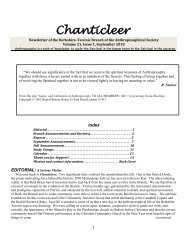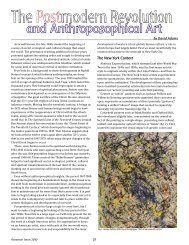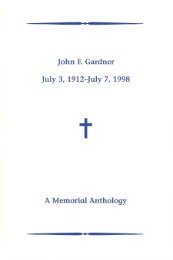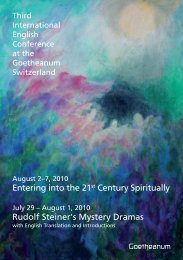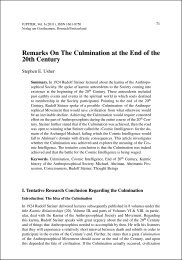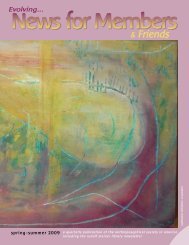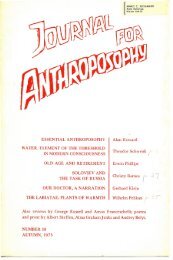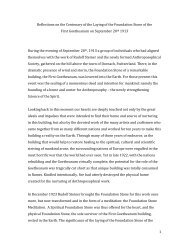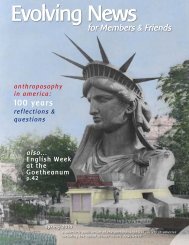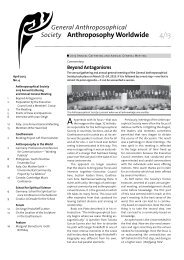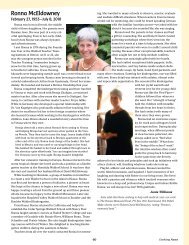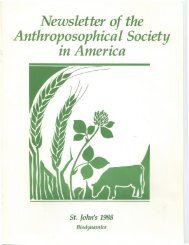& Friends - Anthroposophical Society in America
& Friends - Anthroposophical Society in America
& Friends - Anthroposophical Society in America
Create successful ePaper yourself
Turn your PDF publications into a flip-book with our unique Google optimized e-Paper software.
What’s Happen<strong>in</strong>g <strong>in</strong>the Rudolf Ste<strong>in</strong>er LibraryJudith Soleil, Library DirectorBook Reviews. Here’s coeditor FredDennehy’s <strong>in</strong>troduction to book reviewsthe library commissioned for this issue:John Keats’s concept of “negativecapability” animates both of the longerreviews <strong>in</strong> this issue. Christ<strong>in</strong>a Roottakes an excit<strong>in</strong>g look at The RomanticEconomist: Imag<strong>in</strong>ation <strong>in</strong> Economics byRichard Bronk, a British professor ofEuropean political economy. A recentbestseller by Richard Holmes, The Age ofWonder, widely available <strong>in</strong> bookstoresand public libraries, <strong>in</strong>vestigates Romanticism’scontribution to the imag<strong>in</strong>ativeperspective that <strong>in</strong>formed the passionateand groundbreak<strong>in</strong>g <strong>in</strong>vestigations (oftenby amateurs) of astronomy, chemistry,evolution, and other discipl<strong>in</strong>es <strong>in</strong> then<strong>in</strong>eteenth century. Bronk, similarly,takes the usual literary understand<strong>in</strong>gof Romanticism far afield—here <strong>in</strong>to the“dismal science,” economics. As Ms. Rootpo<strong>in</strong>ts out so perceptively, the capacity tolive <strong>in</strong> uncerta<strong>in</strong>ty, which is the essence of“negative capability,” implies an opennessthat rejects the habitual assumption thatthe answer to any question—economic,scientific, or literary—must necessarilycome from the past.Our second review, by Joyce Reilly,surveys a number of f<strong>in</strong>e new books oncurative education, all of which concernthe Camphill movement or its roots <strong>in</strong>Rudolf Ste<strong>in</strong>er’s curative education course.If there is a common theme among thesefive books it is the determ<strong>in</strong>ation of RudolfSte<strong>in</strong>er, Karl Koenig, and Paul Marshall Allento look at children with special needsand developmental challenges with thedeep respect of an open eye, see<strong>in</strong>g themnot <strong>in</strong> the way they deviate from the restof humanity but for what they br<strong>in</strong>g tohumanity, particularly <strong>in</strong> the way of newmean<strong>in</strong>g. Ms. Reilly, with her long-timedirect experience <strong>in</strong> curative care (reflected<strong>in</strong> her writ<strong>in</strong>g), is especially suited tospeak about the movement <strong>in</strong> general andthese volumes <strong>in</strong> particular.Book reviews beg<strong>in</strong> on page 10.Future. The society’s general councilappo<strong>in</strong>ted a task force last year to evaluatethe library’s space needs. Currentquarters, while lovely, are damp, cramped,and at risk for fire. The task force recentlyreported on their work, andthe council is consider<strong>in</strong>gseveral options. We’ll keepyou posted.Automation cont<strong>in</strong>uesapace. There are now over9000 volumes <strong>in</strong> the library’sonl<strong>in</strong>e public access catalog:http://rsl.scoolaid.net . Contactus to create your own account,which will allow youto request books onl<strong>in</strong>e.Preservation. Assistantlibrarian Judith Kiely is approach<strong>in</strong>gher f<strong>in</strong>al year ofstudy for a master’s degree<strong>in</strong> library science. She recently attendeda preservation workshop <strong>in</strong> Albany, NY.Judith Soleil will attend a book repair workshop<strong>in</strong> December.Francis Edmunds. We recently receiveda set of v<strong>in</strong>tage videocassettes: renownededucator Francis Edmunds lectur<strong>in</strong>g onShakespeare, with illustrative scenesacted by Emerson College (Great Brita<strong>in</strong>)students. We <strong>in</strong>tend to have them transferredto DVD so that they can be enjoyedwidely. Unfortunately, number 6 <strong>in</strong> the setis damaged. Does anyone have a work<strong>in</strong>gcopy we could borrowAlbert Steffen. We have extra copiesof hardcover editions of Albert Steffen’sworks <strong>in</strong> both English and German. Let usknow if you’d like to purchase any of these($10/volume <strong>in</strong>cludes shipp<strong>in</strong>g) and we’llsee if we have the titles you’re look<strong>in</strong>g for.Top Ten! It’s <strong>in</strong>terest<strong>in</strong>g to see whatlibrary patrons are read<strong>in</strong>g. The ten mostborrowedtitles <strong>in</strong> the past 11 months are:1. Zajonc, Arthur. Meditation as ContemplativeInquiry: When Know<strong>in</strong>g Becomes Love.2–4. Ste<strong>in</strong>er, Rudolf. The Inner Realities ofEvolution; An Outl<strong>in</strong>e of Esoteric Science;Education as a Social Problem.5. Kühlew<strong>in</strong>d, Georg. The Light of the” I”:Guidel<strong>in</strong>es for Meditation.6-8. Ste<strong>in</strong>er, Rudolf. The Fifth Gospel; KarmicRelationships, vol. 1 and vol. 6.9. Powell, Robert, and Kev<strong>in</strong> Dann. Christand the Maya Calendar: 2012 and the Com<strong>in</strong>gof the Antichrist.10. York, Jamie. Mak<strong>in</strong>g Math Mean<strong>in</strong>gful: aMiddle School Math Curriculum for Teachersand Parents.Appeal. Please help the library end theyear on a firm foot<strong>in</strong>g. It’s not too late tohelp us meet our annual appeal goal for2009.Library AnnotationsBrief descriptions of new booksavailable from the Rudolf Ste<strong>in</strong>er Library[js=Judith Soleil, jk=Judith Kiely]Anthroposophy—Rudolf Ste<strong>in</strong>erEurythmy Forms for Tone Eurythmy,Volume IX, (K24), Ste<strong>in</strong>erBooks, 2009,191 pgs.This volume, translated by Marsha Post,is a complete English edition of the Germanbibliographic # K24. Conta<strong>in</strong><strong>in</strong>g 160 reproductionsof Ste<strong>in</strong>er’s orig<strong>in</strong>al tone eurythmyforms, the book also <strong>in</strong>cludes an <strong>in</strong>troductionby Dorothea Mier; the <strong>in</strong>troduction fromthe German edition by Eva Fröbose; twoexcerpts from lectures by Ste<strong>in</strong>er: “Music <strong>in</strong>Comparison to the Other Arts” (December 3,1906; GA 283) and “The Experience of Majorand M<strong>in</strong>or” (February 19, 1924; GA 278); andan article by Hendrika Hollenbach, “The FirstBeg<strong>in</strong>n<strong>in</strong>gs of Tone Eurythmy.” —jkThe Karma of Anthroposophy: RudolfSte<strong>in</strong>er, the <strong>Anthroposophical</strong> <strong>Society</strong>and the Tasks of its Members, (from GA237, 238 & 240), compiled and edited byMargaret Jonas and Matthew Barton,Rudolf Ste<strong>in</strong>er Press, 2009, 179 pgs.In this new compilation of lectures bySte<strong>in</strong>er from 1924 to members of the <strong>Anthroposophical</strong><strong>Society</strong>, editors Margaret Jonasand Matthew Barton have brought togethermaterial that focuses on the karma ofsociety members and their task to revitalizecivilization. “Today humanity stands beforea great crisis: either it will see all civilizationcollaps<strong>in</strong>g <strong>in</strong>to the abyss, or else spiritualitywill raise civilization up by the power of the8 Evolv<strong>in</strong>g News for Members & <strong>Friends</strong>



